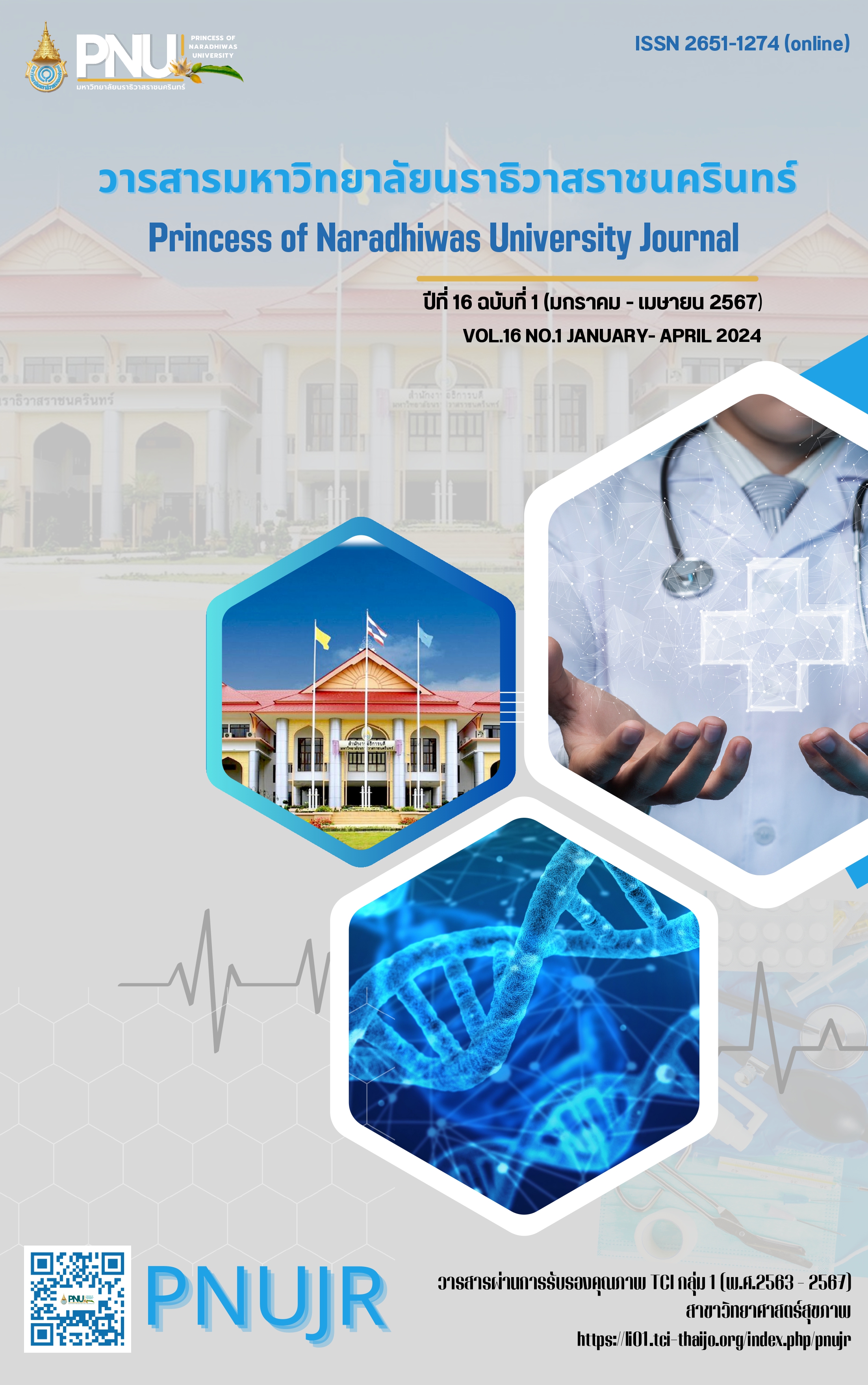Adverse Drug Reactions among Patients with Cancer Undergoing Chemotherapy Following Discharge from the Hospital and the Factors Contributing to Adverse Drug Reactions in Sungai - kolok, Narathiwas Province
Tatchai Tanchaitechawut
Keywords:
Adverse drug reactions, Severity, patients with cancer, Chemotherapy, Hospital dischargeAbstract
This study aimed to assess the frequency, severity, and factors contributing to adverse drug reactions among patients with cancer undergoing chemotherapy following discharge from Sungaikolok, Narathiwas province by monitoring, and assessing the severity of adverse drug reactions using the Common Terminology Criteria for Adverse Events (CTCAE) version 5.0 by pharmacists. While the data on the factors contributing to adverse drug reactions were assessed by using Chi-square test and Fisher's exact test. The results found that out of 44 samples, 23 samples (52.3 %) had a CA colon diagnosis. They underwent 192 cycles of chemotherapy. FOLFOX4 was the most often used chemotherapeutic treatment (55.2 %). The three most frequent adverse drug reactions, with nearly identical severity levels of 1, were fatigue (43.2 %), hair loss (391.9 %), and nausea (38.5 %). The findings of this study indicated that gender, underlying disease, cancer type, age, marital status, stage of cancer, and chemotherapy regimen were all associated with adverse drug reactions. This study was unable to accurately examine the correlated factors contributing to adverse drug reactions due to the limited number of sample size and chemotherapy treatment cycles. It is crucial for pharmacists to follow patients with cancer undergoing chemotherapy because they can review, manage, and monitor for adverse drug reactions that can be prevented or lessened in the severity level. Consequently, further research needs to be conducted in the future.
References
Aslam, M.S., Naveed, S., Ahmed, A., Abbas, Z., Gull, I., & Athar, M.A. (2014). Side effects of chemotherapy in cancer patients and evaluation of patient’s opinion about starvation based differential chemotherapy. Journal of Cancer Therapy, 5, 815 - 822.
Chan, H.K., & Ismail, S. (2014). Side effects of chemotherapy among cancer patients in a Malaysian General Hospital: Experiences, perceptions and informational needs from clinical pharmacists. Asian Pacific Journal of Cancer Prevention, 15(13), 5305 - 5309.
Choorassamee, J. (2019). Medication errors and adverse drug events in patients receiving antineoplastic agents. Thai Journal of Pharmacy Practice, 11(4), 743 - 753.
Elmets, C.A. (2017). Photosensitivity disorders (photodermatoses): Clinical manifestations, diagnosis and treatment. Up to Date. Retrieved September 3, 2022 from https://www. uptodate.com/contents/photosensitivity-disorders-photodermatoses-clinical-manifestations-diagnosis-and-treatment
Glimelius, B. (2005). Benefit-risk assessment of irinotecan in advanced colorectal cancer. Drug Safety, 28, 417 - 433.
Karthikeyan, G., Jumnani, D., Prabhu, R., Manoor, U.K., & Supe, S.S. (2012). Prevalence of fatigue among cancer patients receiving various anticancer therapies and its impact on quality of life: A cross-sectional study. Indian Journal of Palliative Care, 18(3), 165 - 175.
Krishnamurthi, S. S., & Kamath, S. (2022). Chemotherapy-associated diarrhea, constipation and intestinal perforation: pathogenesis, risk factors, and clinical presentation. Retrieved September 3, 2022 from https://medilib.ir/uptodate/show/2824
Krishnarajan, D., Sivasakthi, K., Ariyamol, R., Kumar, D. N., & Varghese, S. (2021). A prospective observational study of chemotherapy-induced adverse drug reaction and the quality of life in cancer patients in a tertiary care hospital. Journal of Cancer Research and Therapeutics, 17(2), 530 - 536.
Lindley, C.M., Bernard, S., & Fields, S.M. (1989). Incidence and duration of chemotherapy-induced nausea and vomiting in the outpatient oncology population. Journal of Clinical Oncology, 7(8), 1142 - 1149.
Loprinzi, C. L., Lacchetti, C., Bleeker, J., Cavaletti, G., Chauhan, C., Hertz, D. L., … Hershman, D. L. (2020). Prevention and management of chemotherapy-induced peripheral neuropathy in survivors of adult cancers: ASCO guideline update. American Society Clinical Oncology, 38(28), 3325 - 3350.
Naing, L., Winn, T.B., & Rusli, B.N. (2006). Practical issues in calculating the sample size for prevalence studies. Archives of Orofacial Sciences, 1, 9 - 14.
National Cancer Institute. (2017). Common Terminology Criteria for Adverse Events (CTCAE) version 5.0. United State: Author.
National Cancer Prevention and Control Plan Committee. (2019). National Cancer Control Programme 2018-2022. Retrieved July 27, 2022 from http://www.nci.go.th/th/New_web/ officer/. of3.html.
National Comprehensive Cancer Network. (2023). Antiemesis: NCCN Clinical Practice Guidelines in Oncology (NCCN Guidelines®) (Version 2.2023 — May 24, 2023). Pennsylvania: NCCN.
Negrin, R.S., & Treister, N.S. (2022). Oral toxicity associated with systemic anticancer therapy. Retrieved September 3, 2022 from https://www.uptodate.com/contents/oral-toxicity-associated-with-systemic-anticancer-therapy#topicContent
O'Donnell, P.H., & Dolan, M.E. (2009). Cancer pharmacoethnicity: Ethnic differences in susceptibility to the effects of chemotherapy. Clinical Cancer Research, 15(15), 4806 - 4814.
Pearce, A., Haas, M., Viney, R., Pearson, S. A., Haywood, P., Brown, C., & Ward, R. (2017). Incidence and severity of self-reported chemotherapy side effects in routine care: A prospective cohort study. PloS one, 12(10), e0184360.
Rugo, H.S., & van den Hurk, C. (2022). Alopecia related to systemic cancer therapy. Up to Date. Retrieved September 3, 2022 from https://www.uptodate.com/contents/alopecia-related-to-systemic-cancer-therapy
Saraswat, N., Chopra, A., Sood, A., Kamboj, P., & Kumar, S. (2019). A descriptive study to analyze chemotherapy-induced hair loss and its psychosocial impact in adults: Our experience from a tertiary care hospital. Indian Dermatology Online Journal, 10(4), 426 - 430.
Stein, A., Voigt, W., & Jordan, K. (2010). Chemotherapy-induced diarrhea: Pathophysiology, frequency and guideline-based management. Therapeutic Advances in Medical Oncology, 2(1), 51 - 63.
Subongkoch, S., Klongkaew, W., Udompon, N., Loisaratakoon, N., & Punna, P. (Eds.). (2017). Standard manual: Working with chemotherapy drugs and care for patients after receiving the medicine. Bangkok: National Cancer Instiute. (in Thai).
Ubonratchathani Cancer Hospital. [n.d.]. Clinical Nursing Practice Guideline (CNPG): Cancer patients who are receiving chemotherapy. Retrieved September 3, 2022 from http://www.uboncancer.go. th/attach/news_1607308374CNPG.pdf.
Varma, P. P., Subba, D. B., & Madhoosudanan, P. (1998). Cyclophosphamide induced haemorrhagic cystitis (a case report). Medical Journal Armed Forces India, 54(1), 59 - 60.
World Health Organization. (2022). Cancer. Retrieved November 2, 2022 from https://www.who.int /news-room/fact-sheets/detail/cancer
Downloads
Published
How to Cite
Issue
Section
License
Copyright (c) 2024 Princess of Naradhiwas University Journal

This work is licensed under a Creative Commons Attribution-NonCommercial-NoDerivatives 4.0 International License.




